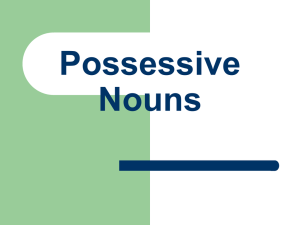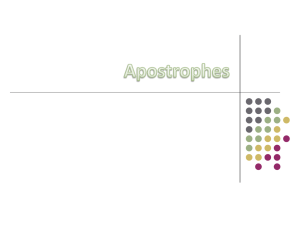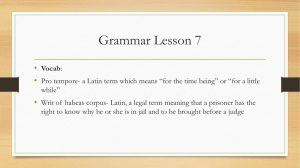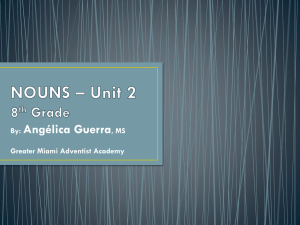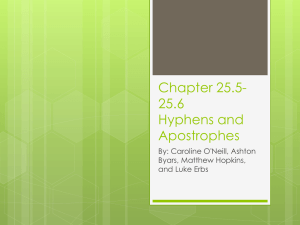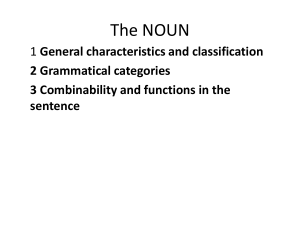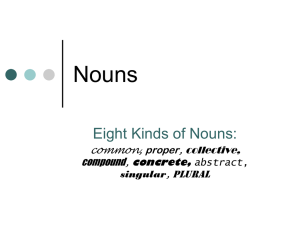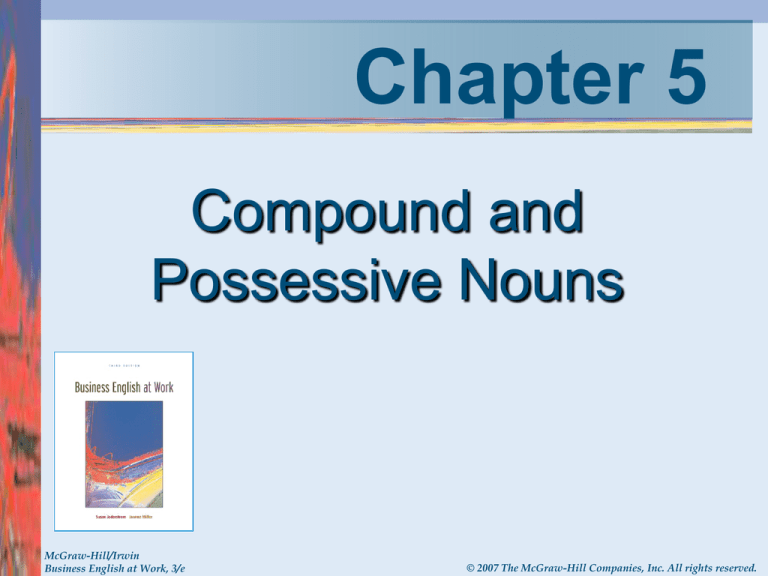
Chapter 5
Compound and
Possessive Nouns
McGraw-Hill/Irwin
Business English at Work, 3/e
© 2007 The McGraw-Hill Companies, Inc. All rights reserved.
Objectives
Form plurals and possessives of compound
nouns.
Recognize nominative, objective, and
possessive case nouns.
Differentiate between plural and possessive
forms of nouns.
Form possessives of singular, plural, and
irregular nouns.
PP 5-1a
Objectives
continued
Identify correct forms of organization,
association, and company names.
Form possessives of abbreviations, joint or
separate ownership, and understood
ownership.
PP 5-1b
Compound Nouns . . .
Consist of two or more words.
May be written as one word, as
hyphenated words, or as two words.
May not be spelled the same in all
dictionaries.
PP 5-2
Plurals of One-Word
Compound Nouns
To form the plural of a one-word compound noun,
follow the general rules for plurals.
birthday
printout
bookshelf
photocopy
birthdays
printouts
bookshelves
photocopies
PP 5-3
Plurals of Hyphenated Compounds
With Nouns
To form the plural of a hyphenated compound noun,
make the most important word plural.
sister-in-law
runner-up
time-out
sisters-in-law
runners-up
time-outs
PP 5-4
Plurals of Hyphenated Compound
Nouns Without Nouns
To form the plural of a hyphenated compound word
without nouns, add the s or es to the last word.
go-between
hang-up
hand-me-down
has-been
go-betweens
hang-ups
hand-me-downs
has-beens
PP 5-5
Plurals of Compound Nouns
With Spaces
To form the plural of a compound noun with spaces,
make the most important word plural.
attorney at law
couch potato
account payable
lieutenant general
attorneys at law
couch potatoes
accounts payable
lieutenant generals
PP 5-6
Cases of Nouns or Pronouns
Nominative nouns or pronouns act as subjects of a
sentence, as appositives, or as subject
complements.
The Webmaster makes all the changes to our
Web pages.
Jerome, our Webmaster, works until 11 p.m.
Jerome is our Webmaster.
PP 5-7a
Cases of Nouns or Pronouns
continued
Objective nouns or pronouns act as direct objects,
indirect objects, objects of prepositions, or objects of
infinitives.
Jackie Huerta supervises our Webmaster.
Jerome gave Jackie the passwords.
Jerome discussed the Web page with Jackie.
Jerome decided to limit access to the network.
PP 5-7b
Cases of Nouns or Pronouns
continued
Possessive nouns or pronouns show that someone or
something owns or possesses something else (another
noun). They may also indicate a relationship between
two nouns.
The Webmaster’s hours were long this week.
Julie’s friend recommended the new software.
PP 5-7c
Possessive Singular Noun
Form the possessive of a singular noun by
adding an apostrophe and s (’s). Always look
for the possessor of an item.
Jerome’s office is always locked.
The manager’s recommendation was
excellent.
The Webmaster’s new graphics are unique.
PP 5-8
Possessive Plural Nouns
Form the possessive of a plural noun that
ends in s or es by adding only an apostrophe.
The customers’ suggestions improved our online order
form.
Form the possessive of a plural noun that
does not end in s by adding an apostrophe
and s (’s).
A color printer is in the children’s classroom.
The women programmers developed a women’s career
Web page.
PP 5-9
Separate and Joint Ownership
Use an apostrophe in all names of persons or
companies to indicate separate ownership of
an item or items.
Troy’s and Michael’s computers
Use an apostrophe in the last of two or more
names to show joint ownership of an item or
items.
Troy and Michael’s reports
PP 5-10
Organization, Association, and
Company Names
Use the form that the company, organization, or
association displays on its logo, product, or
letterhead.
Some companies use an apostrophe and s;
others do not.
Albertson’s Food & Drug
Giovanni’s Italian Delicatessen
Stars Music
Watersavers Irrigation
PP 5-11
Compound Noun
Form the possessive of a singular compound noun by
adding an apostrophe and s at the end of the word.
The stockholder’s shares increased in value this year.
Form the possessive of a plural compound noun that
does not end in s by adding an apostrophe and s at
the end of the word.
The chiefs of police’s duties differed slightly in each city.
PP 5-12a
Compound Noun
continued
Form the possessive of a plural compound
noun that ends in s by adding only an
apostrophe at the end of the word.
The vice presidents’ decision pleased the
employees.
PP 5-12b
Abbreviations
Form the possessive of a singular
abbreviation by adding an apostrophe and s.
the CPA’s report
the CEO’s recommendation
Form the possessive of a plural abbreviation
by adding only an apostrophe.
HMOs’ requirements
Ph.D.s’ offices
PP 5-13
Time and Amounts
Form the possessive of a noun expressing time or
an amount in the same way as other nouns.
a week’s delay
three weeks’ accumulation of e-mail
five hours’ wait
a year’s quota
PP 5-14
Understood Possession
Use an apostrophe and s (’s) or an apostrophe (’)
to show possession of a noun that is understood
but not stated.
Last year’s online sales were better than this
year’s.
Terry’s Web page received more visitors than
Lorie’s.
PP 5-15

